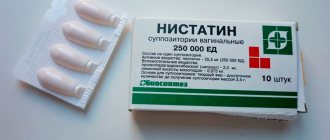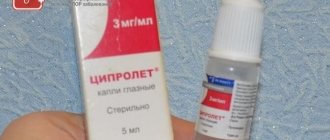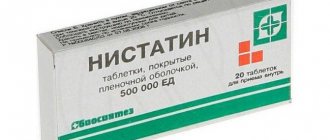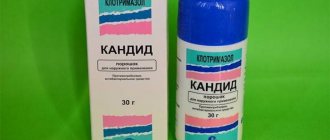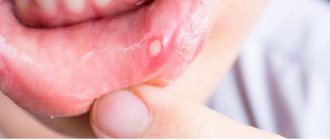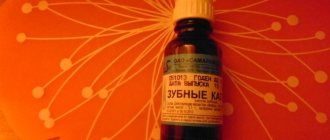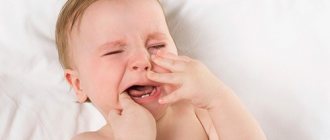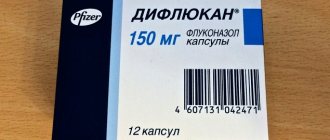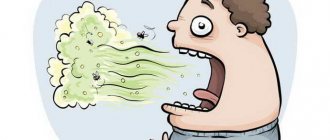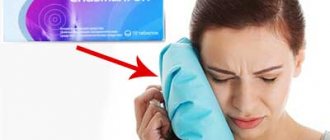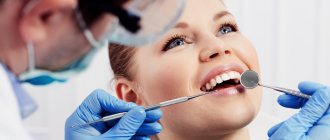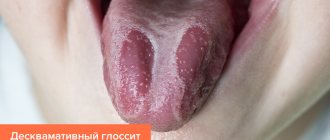Nystatin is an antimicrobial agent active against pathogenic fungi of the genus Candida and Aspergillus. Prescribed for fungal infections of the mucous membranes of the oral cavity, esophagus, digestive tract, and vagina. The drug is contraindicated during pregnancy and breastfeeding, and children under 12 years of age.
Pharmacological group
Nystatin is a drug with antimicrobial action. Pharmacological group – antifungal polyene antibiotics. The drug exhibits a therapeutic effect against pathogenic fungi.
Pharmacodynamics
Nystatin is active against pathogenic fungi from the genus Candida (including Candida albicans) and Aspergillus. The active substance has a tropism for the sterol structures of fungi and is embedded in the membranes of their cells. As a result, channels are formed in the membranes through which electrolytes flow uncontrollably into the cell, which leads to an increase in internal osmolar pressure. The vital processes of fungi are disrupted.
In low doses the drug has a fungistatic effect, in high dosages it has a fungicidal effect. The addiction of pathogenic fungi to the drug develops slowly.
Pharmacokinetics
After oral administration, Nystatin is practically not absorbed from the digestive tract. The bioavailability of the drug is no more than 5%. It is excreted unchanged through the intestines with feces. The part of the medicine that is absorbed in the digestive tract leaves the body in the urine.
Description of the drug
The antifungal component of Nystatin ointment effectively fights mycotic diseases. Its therapeutic effect does not depend on the location of pathological foci or the degree of tissue damage. The drug inhibits fungi that become active during relapses of chronic diseases. As part of complex treatment, it is also used for acute inflammation that occurs after antibiotic therapy. What does Nystatin ointment help with:
- elimination of mycoses that affect the skin, including inguinal folds;
- destruction of yeast-like fungi that multiply on the mucous membranes of the mouth and genitals;
- prevention of the activity of infectious pathogens after a course of treatment with antibiotics from any clinical and pharmacological group.
The drug for local application is rarely used as monotherapy. Pathogenic fungi in most cases begin to grow rapidly with a sharp decrease in immunity. For example, after taking systemic antibiotics or suffering a respiratory or intestinal infection. After reducing the number of bacteria in the body, space is freed up in the biocenosis, which is occupied by fungi. These microorganisms are always present on the skin and mucous membranes, without previously manifesting themselves. To suppress their vital activity, dermatology practices the use of Nystatin ointment. It acts directly on fungal cells and does not destroy beneficial lacto- and bifidobacteria.
Clinical and pharmacological group
Nystatin cream is a representative of the clinical and pharmacological group of antimycotic agents for external use. Its active ingredient is an antibiotic with a polyene structure. Pathogenic microorganisms develop resistance to drugs in this group over a long period of time.
pharmachologic effect
Nystatin ointment is intended for the treatment of fungal pathologies caused by pathogens of the genus Candida. The active ingredient nystatin has a pronounced fungistatic effect due to the presence of double bonds in the structure. This determines the tropism, or affinity of its molecules to certain areas of fungal cells. Nystatin is incorporated into the cytoplasmic membrane, disrupting its integrity. Electrolytes freely penetrate into the cell through the formed channel. The result is an increase in osmotic pressure, loss of stability and destruction of the cell membrane. Nystatin prevents the synthesis of ergosterols, the building blocks of fungal cells, further increasing the antifungal activity.
Release form and composition
The antifungal drug is produced by many domestic pharmaceutical factories. It is packaged in 15 or 30 g quantities in hermetically sealed aluminum tubes. Secondary packaging is a cardboard box with instructions for use included. The active ingredient of the external agent is nystatin, which contains 100,000 units per gram. The ointment base is formed from the following auxiliary ingredients:
- anhydrous lanolin;
- medical Vaseline.
The drug is a thick, homogeneous, transparent substance with a yellowish tint. Nystatin, which is part of the ointment, has antiseptic properties and inhibits not only fungi, but also pathogenic bacteria. Due to its dense structure, the ointment forms a durable film on the surface of the skin and mucous membranes. It serves as additional protection against penetration of pathogenic microorganisms into damaged tissues.
Storage conditions and periods
The optimal place to store the medicine is the side shelf of the refrigerator. At higher temperatures, it exfoliates, changes color and smell. This ointment is not suitable for therapy. The shelf life of Nystatin is 36 months. After the tube’s seal is broken, it is limited to 2-4 weeks.
Nystatin ointment is not an ophthalmic agent, and therefore is not intended for the treatment of eye pathologies.
Indications for use
For adults
Nystatin is prescribed for infections caused by pathogenic fungi of the genus Candida and Aspergilius.
- Candidiasis of the oral mucosa.
- Candidiasis of the esophagus.
- Candidiasis of the digestive tract.
- Vaginal candidiasis (thrush).
- Fungal infection of the skin.
- Prevention of candidiasis of the digestive tract during long-term treatment with antibiotics, cytostatics, glucocorticoids.
Nystatin is prescribed for the prevention of fungal infection in weakened patients, including those with immunodeficiencies.
For children
Nystatin is prescribed in children over 12 years of age. Indications for therapy are the same as for adults.
For pregnant women and during lactation
The drug should not be taken during pregnancy due to the possible risk of toxic effects on the fetus. During the period of breastfeeding, the child is temporarily weaned from the breast.
Analogues and prices
The price of the ointment in question is, as a rule, approximately eighty to one hundred rubles. In the event that Nystatin ointment is not satisfactory or often gives adverse reactions, it makes sense to familiarize yourself with the list of its direct analogues:
- The drug "Mikoseptin" will cost customers four hundred and eighty rubles.
- The drug "Spiramycin" costs two hundred and sixty rubles.
- A medicine called “Fungicidin”, if replacement is necessary, will cost five hundred and twenty rubles.
- The Monural product costs between three hundred fifty and four hundred rubles.
Immediately before purchasing and using the above products, you should carefully and thoroughly read the instructions, and, in addition, the list of active ingredients and contraindications.
Application and dosage
For adults
Nystatin is taken 40-60 minutes before meals. Do not chew the tablet, wash it down with a small amount of water.
Prescribe 1-2 tablets (250,000-500,000 units) 3-4 times a day. The maximum daily dosage is 1,500,000-3,000,000 units. In severe clinical cases, the daily dosage is increased to 4,000,000-6,000,000 units. The course of therapy is continued for 7-14 days. For recurrent forms of infection, treatment is repeated after 3-4 weeks.
For children
Children over 12 years of age are treated according to standard regimens. The maximum daily dose should not exceed 2,000,000 units.
For pregnant women and during lactation
The drug should not be used during pregnancy and breastfeeding.
Features of application
Treatment of genital candidiasis is carried out in both partners. During this period, complete abstinence from intimacy is recommended. During menstruation, treatment for vaginal candidiasis is not stopped.
Nystatin is as effective for men as it is for women. After hygiene procedures, it is applied to the genital organ and placed behind the foreskin.
If side effects occur, stop use.
Nystatin ointment is not prohibited for use in children. However, you cannot use drugs without a doctor’s prescription. Symptoms of thrush and candida skin lesions can be confused with other diseases.
Important! Before prescribing, laboratory tests are necessary, because nystatin effectively affects only the fungi that cause candidiasis. After the symptoms of the disease disappear, use is continued for another 3-4 days to consolidate the therapeutic effect.
After the symptoms of the disease disappear, use is continued for another 3-4 days to consolidate the therapeutic effect.
During pregnancy and lactation
Nystatin ointment, compared to tablets and vaginal suppositories, is a fairly safe treatment for candidiasis during pregnancy.
The decision to prescribe the drug is made by the doctor.
In the first months of pregnancy and mild forms of thrush, the doctor will most likely recommend vitamins and folk remedies (washing with chamomile decoctions, soda solutions, whey).
In the last stages of pregnancy, treatment is usually carried out with medications so as not to infect the newborn.
All decisions about the need to treat thrush during pregnancy with Nystatin ointment are made by the doctor.
Nystatin is not prescribed unless unnecessary during breastfeeding. In this case, the product is used as prescribed by a doctor. The decision to stop breastfeeding is also made by the doctor.
For liver pathologies
Has a toxic effect on the liver. However, use in the form of an ointment does not lead to the accumulation of the substance in the body.
Side effects
Side effects usually occur when high doses of the drug are prescribed.
- Nausea, vomiting, heartburn, loose stool.
- Bitter taste in the mouth.
- Abdominal pain.
- Fever, chills.
- Itchy skin, urticaria.
- Dry cough.
- Increased heart rate.
- Muscle pain.
If side effects occur, reduce the dose of the drug. If the measures taken are ineffective, the drug is discontinued.
Contraindications and special instructions for use
Immediately before using the drug, it is strongly recommended that you read the attached instructions, paying special attention to the indicated contraindications. These include the following:
presence of pregnancy; diagnosing gastric ulcers; existing allergic reaction to the components of the drug; manifestation of sensitivity to the drug; pancreatitis; impaired activity of the kidneys and liver; lactation.
There is a possibility of developing such side effects as nausea, pain, itching, changes in stool, vomiting, and swelling in the oral cavity may also occur. The manifestation of one or more of these symptoms is a compelling reason to visit a qualified specialist.
Proper storage of the medication is also important, which must be kept in a dry and dark place where the temperature is at least six degrees.
Analogs
Instead of Nystatin tablets, you can use the following medications:
- Pimafucin belongs to antifungal agents and is a substitute for Nystatin in the clinical and pharmacological group. The medicine is available in tablets, vaginal suppositories, and cream. The antifungal medication can be used in newborns, pregnant women and breastfeeding women.
- Griseofulvin is an antifungal agent that is produced in tablets. They should not be used by pregnant or breastfeeding women. For children, the drug is prescribed at the rate of 16 mg per kg of weight.
- Nizoral is a substitute for Nystatin in the clinical and pharmacological group. The medicine is available in tablets, creams, and shampoos. It can be used according to strict indications for the treatment of pregnant and lactating women. Tablets are prescribed for children from 3 years old, shampoo from 12 years old.
- Fungoterbine belongs to the Nystatin substitutes in the therapeutic group. The medicine can be taken in tablet form for patients over 2 years of age; they should not be taken by pregnant or breastfeeding women. In addition, the drug comes in a spray and cream, which are not recommended for patients under 12 years of age, but can be used by pregnant women and breastfeeding women.
Features of the drug
Release form
Nystatin comes in several forms:
- Tablets (250 and 500 thousand units);
- Granules for suspension (100 thousand units);
- Ointment (100 thousand units);
- Vaginal suppositories (250 and 500 thousand units);
- Rectal suppositories (500 thousand units).
In granules and tablets, the drug is used for prophylactic purposes, as well as for the treatment of fungal diseases. Granules are especially convenient for children, and tablets can be used to prepare a solution.
Suppositories, in addition to the active substance, also have additional components that make treatment of the intestines and vagina even more convenient and effective.
The ointment used for external use is effective in the fight against skin candidiasis. It also contains lanolin and petroleum jelly, allowing for uniform application.
The video below will tell you about the features of Nystatin against thrush:
Composition of Nystatin
The active ingredient of Nystatin is a polyene antibiotic. And the auxiliary components can be: lactose, potato starch, petroleum jelly, anhydrous lanolin, calcium stearate and other substances.
The cost of the drug depends on the country and manufacturer, as well as on the form in which it is released. So the average cost for Nystatin is:
- Ointment from 60 rub.;
- Vaginal suppositories from 70 rubles;
- Tablets from 128 rub.
Complications and prognosis
The most common complication of fungal bronchitis is pneumonia. The latter occurs when a fungal infection is not treated in a timely manner, and microorganisms penetrate the lung tissue, causing inflammation. Against the background of pneumonia, pleurisy often develops - inflammation of the pleural layers, accompanied by the deposition of fibrin on their surface or the accumulation of fluid in the pleural cavity.
With early complex treatment, the prognosis for fungal bronchitis is favorable. Bronchitis, accompanied by pneumonia against the background of severe immunodeficiency (for example, with AIDS), often ends in death if therapy is not carried out in a timely manner.
Why not just take a tablet or suspension?
The main problem in treating fungal tonsillitis with Nystatin is that this drug cannot be used as a systemic antifungal antibiotic. It is not absorbed either in the stomach, or in the intestines, or in other mucous membranes, and therefore, when it enters the digestive tract in the form of a chewed tablet or suspension, it remains only in the tract itself. It does not penetrate into the blood and does not reach the tissues of the throat, palate and tonsils, which means it will not affect fungal tonsillitis in any way.
It is also useful to read: What you need to know about using Sumamed for purulent sore throat
Similarly, the use of candles is useless. When administered rectally, they dissolve in the rectum and remain here, acting only on fungi located in the intestine.
Thus, oral administration of Nystatin has no effect in the treatment of fungal tonsillitis. Drinking tablets or suspension for fungal infections of the mouth and throat is absolutely useless.
Nystatin is also sold as a ready-made suspension for mouth rinse.
Research shows that in many cases, rinsing the mouth and throat with a Nystatin suspension has a positive effect and allows you to get rid of the disease. This is true only for a suspension prepared from a special powder. The effectiveness of using Nystatin tablets crushed in water is very doubtful and causes skepticism among many doctors.
On a note
Nystatin for fungal sore throat is prescribed only for topical use for 5-7 days. If treatment does not give them an effect, systemic agents are prescribed in the form of tablets or suspensions for swallowing - Fluconazole, Itraconazole, Posaconazole, and sometimes - Amphotericin, Caspofungin in the form of injections. However, in some cases, when fungal tonsillitis is caused by obvious reasons (taking antibiotics, using antiseptics, excess sweets in the diet), even Nystatin is not needed to treat it. If such causes are eliminated, the disease is likely to go away on its own without treatment .
One of the most common antifungal agents, commercially available under several trade names
The final decision on whether to prescribe Nystatin or not is made by the doctor, and whether to take it or not is made by the patient himself or the parents of a sick child. If you decide to take it, you need to do it in accordance with the instructions.
How does Nystatin work?
A drug such as Nystatin is excellent in treating fungal infections, so it is often used for oral thrush. Under the influence of an antifungal substance, the growth and further spread of fungal spores is stopped. Due to the destructive effect on the cell membrane, the death of pathogenic flora occurs. When carrying out a course of therapy with Nystatin, it will be possible to get rid of thrush, as well as prevent the spread of candidiasis throughout the body.
It is worth noting that the drug is not active against pathogenic microorganisms that cause pathological conditions against the background of fungal infection with reduced immune defense.
The drug acts quite quickly, inhibition of the activity of Candida fungi is observed after the first use. The course of antifungal therapy usually lasts about 14 days. and depends on the characteristics of the course of the disease, as well as the presence of an active pathogenic effect.
Nystatin instructions for use, composition, indications, analogues and reviews
Read the official instructions for use of the drug Nystatin in an abbreviated version. It includes: composition, action, contraindications and indications for use, analogues and reviews. The text is provided for informational purposes only and cannot serve as a substitute for medical advice.
The main active ingredient of the drug Nystatin is a polyene antibiotic element. The principle of action of this element of Nystatin is based on its binding to sterol molecules. The latter, in turn, are part of the cell membrane of the fungus.
Composition of Nystatin tablets
Nystatin tablets are coated with a light yellow color with a slight vanilla odor.
- One tablet of the drug contains 250,000 units or 500,000 units of the active ingredient.
- Auxiliary components are lactose, calcium stearate, magnesium carbonate, potato starch, pigment titanium dioxide, petroleum jelly, vanillin flavor.
Composition of Nystatin suppositories
Nystatin is available in the form of rectal and vaginal suppositories.
Nystatin vaginal suppositories are torpedo-shaped and light yellow in color. Two types of vaginal suppositories are available: the equivalent of 250,000 units and 500,000 units. Excipients include propyl ester of paraoxyobenzoic acid, citric acid, Witepsol N-15 and W-35.
Composition of Nystatin ointment
Nystatin in ointment form is used to treat candidiasis of the skin and mucous membranes.
- 1 g of ointment contains 100,000 units of the main active substance.
- The auxiliary substances in this case are anhydrous lanolin and medical vazil.
Nystatin - instructions for use in various dosage forms
Nystatin has antifungal and fungistatic effects. It is an antifungal drug and belongs to the group of polyenes. Shows particular activity against yeast-like fungi of the genus Candida. When using the drug, absorption from the gastrointestinal tract is very poor. When applied topically, absorption into the systemic circulation does not occur at all. Also, the cumulation process does not go through. The process of excretion of Nystatin occurs along with feces.
Recommendations for use in tablets
The tablets can be taken orally in the usual way, or a solution can be prepared from them. When prescribing, you need to take into account the composition in order to avoid individual intolerance to the drug.
Treatment of adults with Nystatin
If internal organs are affected by candidiasis, an adult patient needs to take 500,000 units of the active substance three times a day, regardless of meals. According to the instructions, Nystatin tablets must be swallowed whole; chewing or crushing in any other way is not recommended. The course of use of Nystatin tablets is about 10-14 days, depending on the degree of damage.
With constant relapses, courses of treatment must be repeated periodically, with an interval of 14-21 days between them. The dosage is increased to 6,000,000 units per 24 hours. When treating stomatitis, Nystatin tablets do not need to be swallowed orally. It should be placed behind the cheek and wait until it completely resolves. A single dose in this case is 500,000 units of the active substance. The drug should be taken only after eating and thoroughly brushing your teeth. The number of procedures per day is from 3 to 5.
Since the drug has a direct effect on the mucous membrane of the gastrointestinal tract, Nystatin is therefore effective in the treatment of candidiasis of the digestive tract. For this purpose, Nystatin is taken in the amount of 1-2 tablets equivalent to 500,000 units of the active substance 4 times a day. The duration of use of Nystatin is 14 days or more.
Nystatin: use in the form of suppositories
The instructions note that Nystatin vaginal suppositories must be administered exclusively after hygiene procedures, using 1 suppository for one procedure. It is necessary to carry out two such procedures per day, in the morning and in the evening. The course of application is from 10 to 14 days, depending on the severity of the disease. After the full course, control laboratory tests are carried out, which may show the presence of fungus and require repeat treatment.
Nystatin rectal suppositories, when used, are inserted into the rectum quite deeply, 1 suppository twice a day. One procedure should be carried out in the morning, the second – after 12 hours. The course of treatment is from 10 to 14 days. The composition of rectal suppositories is completely similar to vaginal suppositories.
Nystatin: use as an ointment
For treatment, areas affected by the fungus should be covered with a thin layer twice a day. The full course of treatment is at least a week. This method of using Nystatin can be combined with taking tablets orally.
Use of Nystatin during menstruation
When using Nystatin suppositories during menstruation, there will be no effect from the treatment, since the active substance does not have time to act on the areas affected by candida and is excreted with menstrual flow.
Release form and storage conditions
- tablets of 250,000 units and 500,000 units;
- ointment;
- vaginal suppositories;
- rectal suppositories.
List B. According to the instructions, Nystatin tablets must be stored in a dry and dark place at a temperature of 18 to 20 degrees above zero. Other forms of the drug are stored in the refrigerator at a temperature not exceeding 5 degrees.
Indications, contraindications, side effects of Nystatin
Indications for use of Nystatin
- candidiasis of the mucous membranes, skin, digestive system, vagina;
- antibiotic treatment;
- external use of antibacterial agents, for example, during treatment of the genitals;
- preoperative and postoperative period during surgical interventions.
Nystatin: side effects
Nystatin is not toxic and in most cases is well accepted by the body, however, there are cases of the following side effects:
- lack of appetite;
- diarrhea;
- nausea, which may be accompanied by vomiting;
- allergic reactions in the form of fever, itching, chills.
When the drug is discontinued, all side effects disappear.
Contraindications for the use of Nystatin
- pancreatitis;
- liver dysfunction;
- ulcer after using the product;
- individual intolerance to the components of the drug;
- During pregnancy and breastfeeding.
Nystatin: overdose symptoms
There were no cases of overdose with Nystatin, regardless of the form of release.
Use of Nystatin during pregnancy
According to official instructions, the use of Nystatin in any form is contraindicated during pregnancy and lactation.
Nystatin: use for children
The drug Nystatin is quite popular in pediatrics for the treatment of candidiasis. Oral thrush, which often affects breastfed babies. For treatment based on the drug, a special solution is prepared. Grind 1 tablet with 250,000 units of the active substance into powder and mix with a solution of vitamin B12. Use gauze to lubricate the affected areas of the mouth with the resulting solution. If it is impossible to use the vitamin, it can be replaced with purified water.
The dose of Nystatin depends entirely on the age of the child. Patients under one year of age are prescribed 100-125 thousand units of the active substance 3-4 times a day. For children up to three years old, 250 thousand units 3-4 times a day. Children under 13 years of age are prescribed a dose of 250 or 400 thousand three times a day. Teenagers need to take 250 or 500 thousand units of the active substance 3-4 times in 24 hours.
Interaction of Nystatin with other drugs
The peculiarity of the passage of Nystatin through the body when taken orally in the form of tablets, the number of medications with which it interacts is limited:
- Tetracycline. In combination with this drug, Nystatin has a positive effect on the effects of tetracycline on the body. The antifungal and antimicrobial effect of both drugs is enhanced.
- The effect of Clotrimazole in combination with Nystatin is reduced.
- The effect of the drug is enhanced when taken simultaneously with Polymyxin and Nifuratel, as well as Chymotrypsin.
- The effect of the drug is reduced when combined with the use of all indirect anticoagulants, for example, Coumadin or Warfarin.
- Bactericidal antibiotics also reduce the effect of using Nystatin.
- The effectiveness of using oral contraceptives that contain estrogen with simultaneous use of Nystatin is significantly reduced. There is also an increased risk of heavy bleeding between menstrual cycles.
Nystatin analogues: domestic and foreign
Analogue - Amphoglucamine
Used to treat fungal diseases of the digestive system and internal organs. It is especially active against yeast-like fungi, as well as mycoses, which are systemic in nature. This analogue is prescribed orally after meals twice a day. The course of treatment is at least 10 days. If necessary, the course of treatment should be repeated after laboratory tests.
Nystatin analogue - Amphotericin B
This drug has an antifungal effect on the body against yeast-like fungi, causative agents of systemic mycoses. Amphotericin B is poorly absorbed from the digestive system, and is also absolutely non-toxic when used in other ways. Indications for taking the drug are fungal diseases, the treatment of which with other antifungal drugs has been unsuccessful. This analogue is administered intravenously over 6 hours, the intervals between doses should be at least 24 hours. If you use ointment, apply the drug in a thin layer twice a day for two weeks.
Levorin - an analogue of the drug
This drug shows high effectiveness in the treatment of lesions of yeast-like fungi such as Candida. Can be used to treat children aged two years and older.
Analogue - Mycoheptin
An antifungal drug that is used to treat visceral mycoses. Treatment using Mycohepatin should be carried out under the strict supervision of a physician, who monitors the level of urea and creatinine concentrations in the blood throughout the course of treatment.
www.medmoon.ru
Treatment of stomatitis with nystatin in a small child
The instructions for use of the drug directly indicate the permissibility of using the medication for infants. In pharmacies, Nystatin is presented in the form of drops, ointments and tablets.
For babies who have thrush, the best option is to use a tablet solution. It can be obtained independently - the tablet will need to be carefully crushed into small crumbs and diluted in a solution containing vitamin B12, and the latter is best used in oil form.
After this, the finished mixture is brought to a homogeneous state. In this way, you can dilute nystatin and treat a child for stomatitis.
Treatment of affected areas should be done no more than 3 times a day.
In the absence of a vitamin solution, boiled water is also quite suitable; the effect of such a replacement is similar.
In some cases, the doctor prescribes tablets for infants. How, then, should they be used correctly?
- — The dosage should be a quarter of one tablet.
- — It is unacceptable to feed a baby or give him water within a 30-minute period after taking the medicine.
In a situation where it is intended to use Nystatin drops, the dosage is calculated based on 1 ml of solution for each baby’s cheek. To do this, use a sterile bandage - drops are applied to it, then the areas affected by stomatitis are delicately treated.
The duration of treatment is determined by the degree of damage; the course must be prescribed by a doctor. As a rule, the medicine is used for no more than 10 days.
The popular doctor E. Komarovsky advises not to forget that Nystatin is still an antibiotic, therefore, to treat candidiasis-type stomatitis, you must strictly follow the prescribed dosage.
Diagnostic methods
In order to correctly diagnose oral candidiasis, the doctor must interview and examine the patient. In this case, a number of laboratory tests are necessarily carried out, the most effective of which is considered to be the examination of scrapings from the oral mucosa under a microscope. Patients donate blood for a general analysis and sugar level. The specialist examines the nails and skin of the subject, after which he refers him for a consultation with a mycologist, endocrinologist and gynecologist.
The diagnosis is made on the basis of microscopic examination of scrapings of the mucous membrane. With this disease, fungal microorganisms of the genus Candida are found in the oral cavity. If you have removable dentures, scrapings are also taken from them for microscopic analysis. Biological material is collected in the morning before meals; before this examination, the patient is prohibited from brushing his teeth or rinsing his mouth.
It is quite easy to determine the presence of fungal infection of the oral cavity in the normal, uncomplicated course of the disease. But with the atypical nature of this disease, additional diagnostic methods are used: bacteriological smear analysis, biochemical blood test, endoscopy and x-ray of the esophagus.
How is thrush in the mouth treated? To effectively eliminate this problem, the attending physician selects antifungal medications. Such medications have a strong antimycotic effect - they kill fungal microorganisms, preventing the infection from multiplying and spreading further.
As for the pharmacological form of drugs, for thrush in the mouth in men and women it is recommended to use special sprays and gels. In order to treat oral candidiasis in adults, the patient is allowed to use lozenges and rinse the affected area with antiseptic solutions.
Patients should know that self-administration of antibacterial drugs in this situation often complicates the course of the pathology and transforms the acute form of the inflammatory process into a chronic one. In such a case, the disease may stop its progression for a while, but later it will reappear.
For therapeutic purposes, the following drugs and tablets for thrush are used in adults for this disease:
- Levorin, Nystatin - these medications have a pronounced antifungal effect on the site of infection. The product must be absorbed 4-6 times a day for 10-12 days.
- Decamine – has anti-inflammatory, antibacterial and antiviral properties. The scheme of its use is similar to previous drugs, but such tablets are used much more often - up to 7-8 times a day.
- Diflucan is a systemic antimycotic medicine that effectively eliminates the manifestations of candidiasis. This medicine has a detrimental effect on fungi and can persist in the human body for 24 hours, so it is recommended to take no more than 1-2 tablets of the drug per day.
- Diazolin, Loratadine, Cetrin, Tavegil, Suprastin are tablets with an antihistamine effect. In this situation, they are used to reduce hyperemia and swelling of the damaged mucosa, eliminate itching and burning of the skin.
- Calcium gluconate is a medication that has an antiallergic and restorative effect.
- Potassium iodide 2-3% - the product is used for medicinal purposes for oral thrush in men or women. The solution is taken orally in the amount of 1 tbsp. spoons up to 3 times a day. The medicine destroys pathogenic fungi and prevents dry mucous membranes.
The use of medications in the form of tablets for candidiasis must be supplemented with the treatment of damaged tissue at the site of infection. For local treatment of this disease, the doctor prescribes special gels and ointments with an antifungal or antiseptic effect. When treating thrush on the lips in women, aniline dyes are used to treat the mucous membranes - Decamine 0.5% ointment or Amphoterecin B.
To get rid of thrush in the throat and prevent further spread of fungal microbes, it is recommended to rinse your mouth with solutions of 2% sodium bicarbonate and boric acid. For this purpose, a small amount of antiseptic should be dissolved in 1 glass of boiled water. If mycotic infections occur, it is recommended to lubricate the affected skin with Decamine, Nystatin or Levorin ointment.
How to get rid of thrush in the mouth using alternative medicine? In this case, the use of various infusions and decoctions of medicinal herbs is considered quite effective. Traditional medicines have an anti-inflammatory and wound-healing effect - and this is exactly what is needed for fungal infections of the skin and mucous membranes.
Pathology in an adult can be cured using the remedies listed below.
- Juniper - shoots of this plant are used to create a tincture, which is then used to wipe the affected areas of the mucous membrane.
- Calendula - used as a rinse solution. An alcohol infusion from the leaves and shoots of this herb is diluted in warm water in the amount of 1 tbsp. spoons per 1 glass of liquid. The resulting composition is used to rinse the mouth every 3-4 hours for 2-3 weeks. The product can be taken orally in the form of tea - this relieves inflammation of the epidermis and reduces pain at the site of infection.
- Viburnum, carrot, cranberry juices are natural antibiotics and contain a large amount of useful substances and vitamins. Thrush in the mouth in adults can be treated with these juices within 3-4 weeks. They are used to rinse damaged mucous membranes, as they have good antifungal properties. Carrot juice protects and strengthens the lining of the mouth.
- Sea buckthorn and St. John's wort oils help to painlessly eliminate fungal plaque. A decoction prepared from the herb St. John's wort has a pronounced healing and antimicrobial effect. To create it, brew 1 tbsp. spoon of medicinal plant in 1 glass of hot boiled water.
- Ledum - also used as a rinse solution. A medicinal decoction is prepared from the leaves of this shrub, which can destroy the fungus. The product slows down the growth and development of harmful microflora, due to which the symptoms of candidiasis disappear within 5-6 days. In severe cases of the disease, it is recommended to extend the course of therapy to 2-3 weeks.
- Onions, wormwood, garlic - the juice of such plants can be lubricated with inflamed mucous membranes. But before you treat thrush with this method, you need to get rid of plaque in your mouth. The medicine destroys bacteria and activates the body's immune defense. The duration of therapy is 2-3 weeks.
- Oak bark - the prepared decoction can be moistened with gauze swabs, which should then be applied to the damaged area of the mucous membrane. This treatment method prevents further spread of candida into the deeper layers of the epidermis. The product has a good healing effect. Similarly, you can use decoctions of parsley, chamomile, and celandine roots.
- Aloe, rose hips, olives - prevents the proliferation of pathogenic microbes. Gauze soaked in the oil of these plants is applied to the inflamed area of the skin or mucous membrane. It is recommended to continue treatment for 12-14 days.
Thrush in the mouth can appear in a person at absolutely any age. To prevent its development, it is extremely important to monitor your health and maintain personal hygiene. To prevent the disease from developing into a chronic, recurrent form, it must be treated in a timely manner. In this case, it is better to seek help from a qualified specialist who will make the correct diagnosis and select the most effective drugs for the treatment of this disease.
Found an error in the text? Select it and press Ctrl Enter and we'll fix it!
